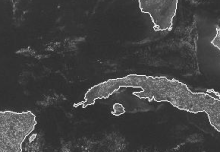
Back منطقة تلاق Arabic कन्वर्जेन्स जोन Bihari Konvergenssi (meteorologia) Finnish Convergence (météorologie) French 収束帯 (気象) Japanese Конвергенция зонасы Kirghiz അഭിസരണം Malayalam Konvergenssone NN Strefa konwergencji Polish Zona de convergência (meteorologia) Portuguese

A convergence zone in meteorology is a region in the atmosphere where two prevailing flows meet and interact, usually resulting in distinctive weather conditions.[1] This causes a mass accumulation that eventually leads to a vertical movement and to the formation of clouds and precipitation.[1] Large-scale convergence, called synoptic-scale convergence, is associated with weather systems such as baroclinic troughs, low-pressure areas, and cyclones. The large-scale convergence zone formed over the equator, the Intertropical Convergence Zone, has condensed and intensified as a result of the global increase in temperature.[2] Small-scale convergence will give phenomena from isolated cumulus clouds to large areas of thunderstorms.
The inverse of convergence is divergence, such as the horse latitudes.
- ^ a b LEUNG Wai-hung (June 2010). "Meteorology Basics: Convergence and Divergence". Hong Kong Observatory. Retrieved November 25, 2015.
- ^ Byrne, Michael P.; Pendergrass, Angeline G.; Rapp, Anita D.; Wodzicki, Kyle R. (2018). "Response of the Intertropical Convergence Zone to Climate Change: Location, Width, and Strength". Current Climate Change Reports 4: 355-370. doi:10.1007/s40641-018-0110-5
© MMXXIII Rich X Search. We shall prevail. All rights reserved. Rich X Search